Cycle: ( noun) A series of events that are regularly repeated in the same order (Oxford Dictionary)
How Milankovitch cycles effect Earth’s climate
Natural cycles are all around us; tides, seasons, sun spots, birthdays, El Niño. In geology we can identify cycles at many different scales, from the really grand to the wafer-thin (deference to Monty Python), from those that span eons, to cycles that repeat every few seconds. Perhaps the grandest of earth cycles are those that last 100-300 million years and involve the formation and destruction of tectonic plates. On a more human time scale there is the seemingly never-ending train of waves rushing to meet you on your favourite beach.
Cycles are also common in sedimentary strata. One frequently encountered example (photo above) describes sedimentary layers that were deposited in progressively shallower water, where the bottom layers accumulated out on the continental shelf (100m or so water depth) and the uppermost layers at the beach (zero water depth). We refer to these progressive changes in the ancient environments as shallowing-upward cycles; there are also deepening-upward cycles. They form because there is a change in the relative sea-level and position of the ancient shoreline. Cycles like these can be a few centimetres to many 10s of metres thick. Many cycles can be stacked one on the other as shown in the photo above. Discussions and debates continue in the geological community about how such cycles form; what are the driving mechanisms that produce the relative fall or rise in sea level that results in such regular repetitions of strata.
Glaciations are also cyclical. They seem to occur about every 100,000 years – at least they have done so for the last couple of million years. The last glaciation began about 110,000 years ago and the ice-sheets began to recede about 18000 years ago. Ice-core temperature data from Antarctica demonstrates this glaciation cyclicity very nicely.
An important scientific question; what causes this kind of cyclicity? A supplementary question might be ‘can established cycles be perturbed by other forces or processes that in themselves are not cyclical?’.
Astronomical wobbles
Cycles are usually driven by some kind of external process or force. Plate tectonic forces that produce oceans and mountain belts tend to operate over very long periods of geological time; we cannot invoke these forces to explain cycles of much shorter duration like the sedimentary and glacial cycles. Enter Milutin Milankovitch, a Serbian mathematician and engineer, born 1879 (d 1958). He was a contemporary of Alfred Wegener who was one of the first to enunciate a theory of Continental Drift, the precursor to modern plate tectonic theory.
Milankovitch is best known for his theories on solar insolation and planetary orbits that provide mechanisms to change earth’s climate at regular intervals. He was particularly interested in the periodicity of glaciations. Although astronomers like John Herschel (1792-1871) had considered the possibility of astronomical forcing of climate, it was Milankovitch who developed the mathematical models that we now refer to as Milankovitch Cycles.
Earth’s rotation and orbit around the sun is not a smooth, continuous circle but an ellipse that is perturbed by ever-changing wobbles and tilts. Milankovitch theory outlines three kinds of orbital cycle: Precession, Obliquity and Eccentricity. The cycles are influenced by gravitational interactions between the earth, sun and moon, and to a lesser extent the planets. Note that Milankovitch did not actually discover these three orbitals. The Greek astronomer Hipparchus discovered Precession about 200BC; Ancient Chinese and Indian astronomers also were well versed in earth’s astronomical wobbles.
Precession
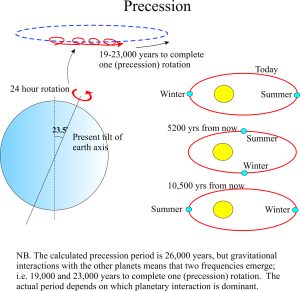 A nice analogy for this orbital hiccup is a spinning top. A top will spin about its axis but if it is nudged it will begin to wobble or precess (while still spinning). The earth takes 24 hours to spin about its axis. However, the earth also wobbles. In this case, earth’s rotation is perturbed by a middle-aged spread about its equator, aptly called the equatorial bulge. Whereas a single wobble of a spinning top is very fast, the same process for earth takes from 19,000 to 23,000 years.
A nice analogy for this orbital hiccup is a spinning top. A top will spin about its axis but if it is nudged it will begin to wobble or precess (while still spinning). The earth takes 24 hours to spin about its axis. However, the earth also wobbles. In this case, earth’s rotation is perturbed by a middle-aged spread about its equator, aptly called the equatorial bulge. Whereas a single wobble of a spinning top is very fast, the same process for earth takes from 19,000 to 23,000 years.
As shown in the cartoon, each wobble rotation takes earth closer or farther from the sun during its yearly journey around the sun. Precession is directly responsible for changes in solar intensity (insolation) on time scales of 100s to 1000s of years. At present northern hemisphere summers occur when earth is farthest from the sun (called aphelion). However, in about 10,500 years this situation will be reversed. Precession is also responsible for periodic changes to the (north) Pole Star; Polaris is presently over the north celestial pole, but in about 11000 years Vega will be closest to the pole.
Obliquity
The earth’s axis is presently tilted at 23.5o to the plane of earth’s orbit around the sun (called the ecliptic); the tilt is directly responsible for our seasons and is decreasing. To further complicate matters, the plane of earth’s orbit around the sun (ecliptic) is also precessing (wobbling); the period of this cycle is 71,000 years. The combined effects of axial precession and ecliptic precession cause earth’s tilt to move between 21.5o and 24.5o, a shift that takes 41,000 years. Although seemingly modest, the changes in obliquity can impact the severity of seasons. At the lowest tilt the sun is distributed a bit more evenly so that seasonal variations are likely to be less inclement. Importantly, precession cycles will be superimposed on the longer obliquity cycles.
Eccentricity
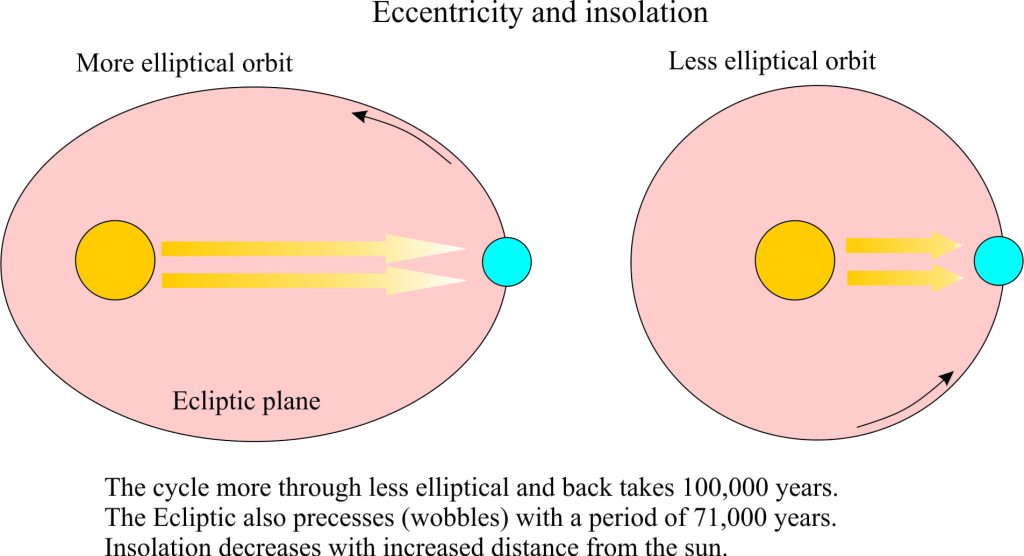 The third cycle identified by Milankovitch as having an influence on global climate describes the earth’s orbit around the sun. The orbit is an ellipse that alternates between increasing and decreasing degrees of ellipticity (there is about a 5% change) over periods of 100,000 years. The change in orbit, although seemingly small, produces significant differences in solar intensity as earth moves closer or farther from the sun. Again, these are longer terms changes in orbit, on which both obliquity and precession are superimposed.
The third cycle identified by Milankovitch as having an influence on global climate describes the earth’s orbit around the sun. The orbit is an ellipse that alternates between increasing and decreasing degrees of ellipticity (there is about a 5% change) over periods of 100,000 years. The change in orbit, although seemingly small, produces significant differences in solar intensity as earth moves closer or farther from the sun. Again, these are longer terms changes in orbit, on which both obliquity and precession are superimposed.
Back to earth
All three orbital cycles, acting together, produce complex but predictable changes in insolation. According to Milankovitch theory there should be glaciations and other periods of significant cooling-warming every 100,000, 41,000 and 23,000 years.
One of the great discoveries from work on ancient deep-sea sediments (for example in the Joides and Ocean Drilling programs) and from Antarctic ice-cores is the remarkable degree of correlation between glaciations and eccentricity cycles, with higher frequency warming and cooling periods superimposed on these 100,000 year trends. It is now generally accepted that these orbital cycles are important drivers for climate change and that the higher frequency cycles (obliquity and precession) are also involved in complex feed-back among insolation, precipitation and albedo. Perturbation of earth’s orbit also causes climatic regions to migrate; the tropic circles, although defined by astronomical terms, also separate the broadly tropical from temperate climate regions The tropics are moving towards the equator and the polar circles towards the poles at 15m/year. Additional factors that influence, or perturb the astronomical cycles over similar time-frames are:
- volcanism (addition of dust and aerosols into the upper atmosphere tends to have a cooling effect), although they generally have short residence times in the atmosphere.
- Changing ocean currents that may be affected by addition or subtraction of cold water, and
- According to climate change science, human activities that alter the balance of gases like carbon dioxide and methane in the carbon cycle.
The present state of affairs
The IPCC graph shows the predicted Milankovitch orbits for about 50,000 years from now. The eccentricity curve indicates that earth is in a cooling phase. We can expect full glacial conditions in about 20,000 to 30,000 years but there is no need to panic just yet. Within this time frame we can probably expect the odd, brief warming or cooling, like the short-lived events during medieval times and about 3000 years ago, that resulted from small changes in obliquity and precession (axis tilt 3000 years ago was closer to 24o). Under normal conditions we would expect carbon dioxide and air-sea temperature trends to follow suit i.e. lower atmospheric CO2 concentrations during glaciations, peaking at about 280-300ppm during interglacial periods (note on the graphs that 0 time is 1950). However, both of these variables are currently trending in the opposite direction; both CO2 and surface temperatures are increasing. These observations, now confirmed with a high degree of confidence, are central to climate science. These data trends require a scientific explanation regardless of one’s position for or against anthropogenic-driven climate change. Climate change science posits the theory that increasing CO2 and temperature are perturbing the natural Milankovitch cycles. Those who disagree argue that these trends are part of natural cycles or that the data is corrupted in some way. Modern science for the most part supports the former position.
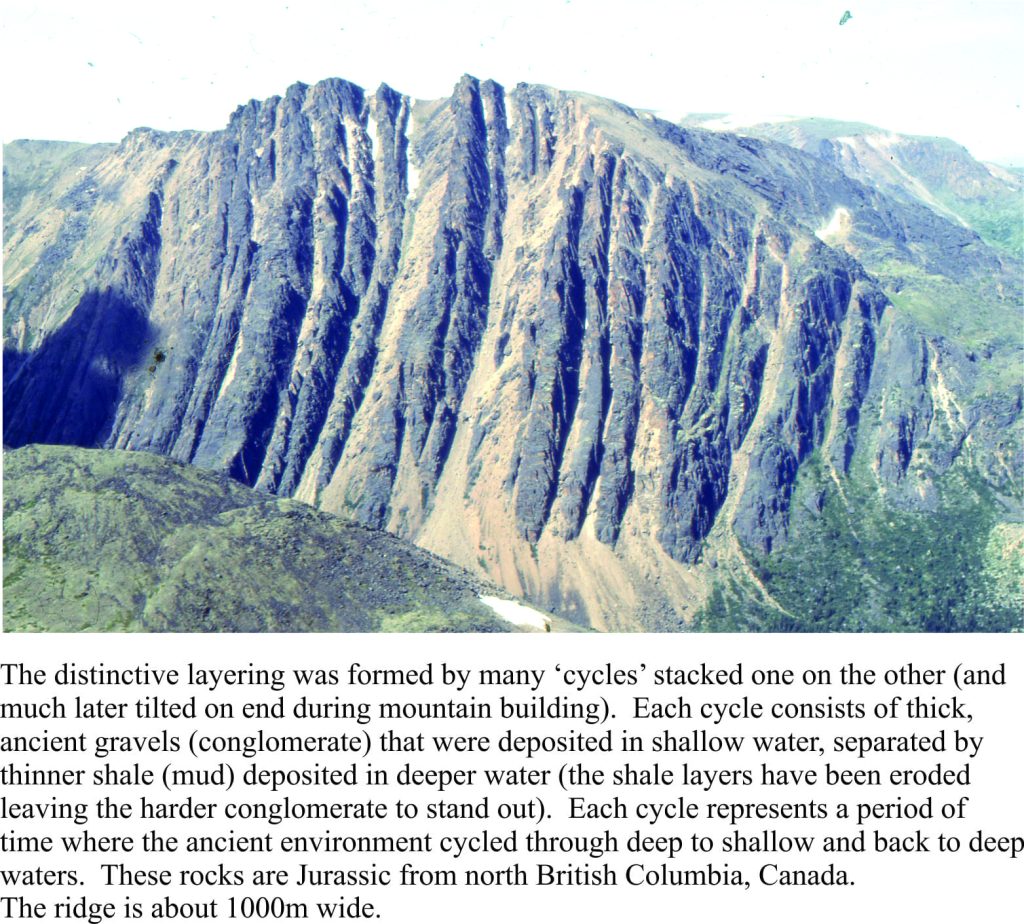
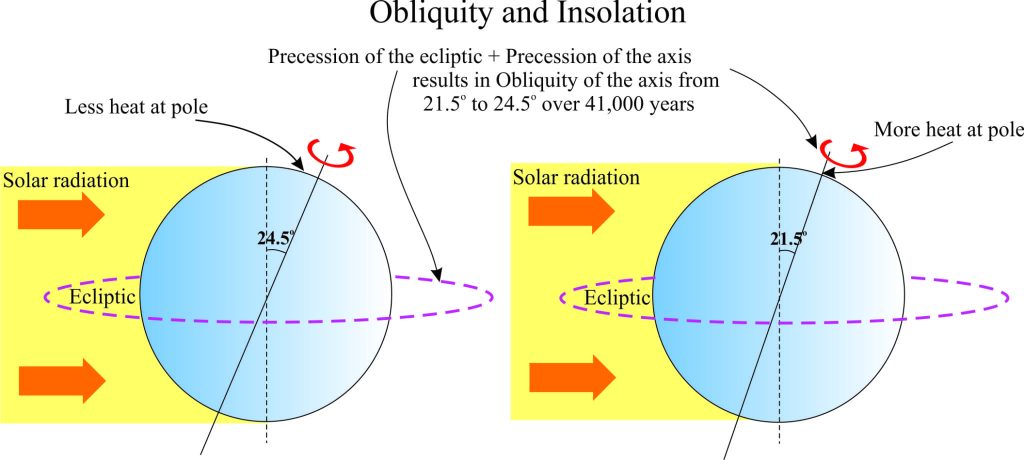
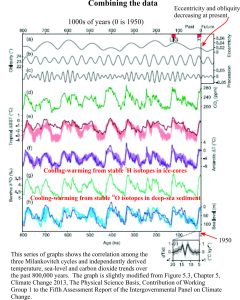


















4 thoughts on “Astronomy, Cycles and Climate Change”
Rather interesting, I have kind of instinctively always felt that the enormity of the Sun’s influence is what we have to suffer and/or celebrate today although I also think that in a more localised way high CO2 and other stuff will cause distortions of the cycle. So yes, let’s go on making “reasonably” clean and economic Electricity and Transport and stop the silly politically dangerous games (camouflaged by religious and racial aberrations), with O&G.
Hector D Susman
Thanks Hector. Seems like the sensible thing to do but I’m not sure we always take the sensible route
Pingback: Information in the ‘Post-Truth’ Age | 5280 Group
Pingback: Gravity Between Mars And Earth Drives Climate And Currents